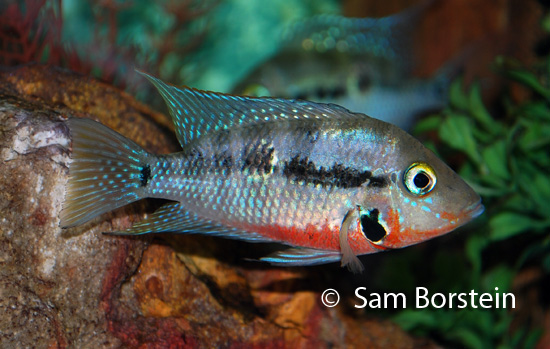Thorichthys meeki
(Brind, 1918)
Firemouth Cichlid
Synonyms: Cichlasoma meeki

Above: A female Firemouth tending to eggs. Photo by Sam Borstein.
Etymology:
Genus- Thor= rushing (Greek), ichthys= fish (Greek).
Species- meeki= named for Seth Eugene Meek.
Intro:
The Firemouth is one of the most popular fish ever in the hobby. Even non-cichlid keepers know of this fish and their reputation of being nasty, but being terrific parents.
Distribution:
This fish is found in Southern Mexico and Guatemala in lakes and creeks.
Size, Maturity, and Sexual Dimorphism:
Size: Males- 6 inches, Females- 4.5 inches
Maturity: 2.5 inches
Sexual Dimorphism: Males are a little bit larger than females and have a longer dorsal fin.
Care:
Firemouths can be pretty nasty, so be sure to give them some space. A small breeding pair could be put in a 20 with some dither fish to beat on. Ideally a 40 breeder or larger would be used for a large breeding pair. Other than that, this fish is really not hard to care for. This fish is tough and can be in some pretty bad water, although you should do water changes weekly.
Diet:
Firemouths are omnivorous, so a mix of everything should be fed. It is a good idea to feed this fish with a hearty food such as Spectrum or Tetra Cichlid sticks, as it gets the fish into good condition.
Breeding:
Firemouths are great parents... well, ok parents. For me they didn't live up to their reputation. I originally got 3 Fire Mouths from fellow GCCA member Ric Perez. They were all very small, so I got an extremely large male that was six inches. Although these guys didn't live up to their reputation as good parents, they sure were fighters. The fish were in my dad's 90 gallon, and in with the Fire Mouths was a breeding pair of Neolamprologus cylindricus. When we put in the large male we gut, he was going crazy. He saw the females, and wanted to spawn, but the N. cylindricus kind of got the "Not in my house" point across. All of the sudden, about ten minutes after we put the big male Firemouth in the tank, he and the cylindricus were squaring off. They fought for a good twenty minutes. Guess who won.

Above. A Firemouth squares of with a Neolamprologus cylindricus. Photo by Rick Borstein.
If you guessed N. cylindricus , you win! The cylindricus won by a knockout. The male Firemouth was all beaten up and when a fish is bleeding underwater, you know it isn't good. But the Firemouth wouldn't give up. I had just set up a 75, so we took the male Fire Mouth out, and put him there. A week later, I took the other Fire Mouths from the 90, and placed them into my 75, with some Yellow Labidochromis.
A week later all the Labidochromis were killed and a day after that my Firemouths bred. I was a little worried, because two days after they bred, I was going to Florida for a week. When I left, the eggs were 200-250 wrigglers. When I have baby fish the first thing I usually feed them is baby brine shrimp, but I had no way of feeding them that, so I put the best substitute, cyclopseeze into an automatic feeder.
When I got back there were fifty babies. I was thrilled, I had enough to get a BAP, but not enough that would drive me crazy thinking of ways to get rid of them. I really understood why everyone said they were good parents. I left them with the parents, because I thought they were doing a real good job.
The fry were doing fine, but every day it seemed that I had less fry. Sure enough my eyes were not tricking me. A week later my dad, who goes into my fishroom a lot, (and sometimes takes things he likes that he can get an easy BAP off of) said he saw my large male Fire Mouth sucking up fry, and eating them. I didn't believe him. That night we had family from out of town over for dinner. It was getting late, so my dad told me to go feed the fish. I did, and when I was feeding baby brine shrimp to my Fire Mouth babies, I found out my dad was right. I was down to six, and that was cutting it close. The fry were large, close to a half inch, so I netted them out of the tank, and placed them into a ten. I raised them up, and then finally Bap'd them.
I've more recently kept Firemouths and my experience this time was the polar opposite. I had some f1 Firemouths from Rio Subin, Guatemala breed in a 40. With about 10 other firemouths, the pair, only 2 inches successfully raised fry. It was much more enjoyable to see them care for their fry this way! Truly, this pair lived up to the stereotype of Firemouths being fine parents.
Conclusion:
The Firemouth is an aquarium classic. Although rather common, it is a species every cichlid nut should keep at one point to witness the fantastic parental behavior.
References:
- Brind, W.L. (1918) A new subspecies of Thorichthys helleri. Aquatic Life, 3, 119-120.
- Miller, R.R., Minckley, W.L. & Norris, S.M. (2005) Freshwater Fishes of México. Museum of Zoology, University of Michigan, & University of Chicago Press, Chicago, 652 pp.
